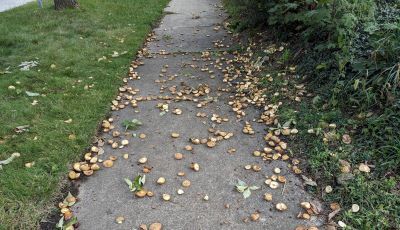
Good Natured: Welcome to Mast Year 2023!
If you've thought, lately, that you're going nuts, guess what? You're not alone!
Here in Kane County, as well as other areas of northern Illinois, it would appear that our fruit- and nut-producing trees are going absolutely bonkers. In more scientific terms, we are in the middle of a mast year.
(Here's a little detail you didn't know you needed: Mast, in this sense, is a word derived from the old or shall we say olde English word maest, which means fodder, and referred to items consumed by livestock.)
The effect to me is most notable among our oak trees—but that might be because I daily risk life and limb to navigate the profusion of bur oak acorns in front of Good Natured World Headquarters. If I didn't know better, I'd think our magnificent century oak was out to get us. Its acorns, which are the size of marbles/gumballs/ball bearings and just as round, cover our sidewalk and porch and make navigation, at least by this preoccupied and innately clumsy naturalist, a tad tricky.
Thankfully I'm always up for a challenge. But what grabs me even more is just how diverse this year's phenomenon appears to be. Our cottonwoods got things started in late spring with their prodigious production of downy white seeds; then came the elms, then maples, then hackberries. Now the oaks, hickories, walnuts, horse chestnuts, buckeyes, basswood, apples, plums, pears…pretty much every tree species in the area has joined in in the ritual of cranking out seeds.
(More fun with mast: Trees' output can be divided into two categories, hard and soft. Hard mast is what clunks you on the head, hard. Acorns, hickory nuts and walnuts are good examples of hard mast. Soft mast hits a little more gently—think cottonwood fluff, cherries and plums.)
For folks that think, and overthink, these things, investigating this year's enormous mast crop has the potential to pull us down an ever-deepening rabbit hole of facts, theories, questions and suppositions.
Let's take, for one, the thought that weather conditions play a role. That's certainly true with our wind-pollinated species like oaks, hickories and walnuts, which likely benefitted from our warm, dry spring. But what about the trees like buckeyes, basswood and apples, which require insect pollination? Thinking this through, did those drought conditions drive bees and other pollinators to visit more flowers to get the nectar they seek? And thus spread more pollen along the way?
But if there's one thing modern meteorological technology has taught us, it's that weather can be highly localized. I've always marveled at how, sometimes, I'll get soaked to the skin by a deluge at Hickory Knolls and then later come home to bone-dry conditions in my yard three miles away. This summer, some areas of our region were under flash-flood warnings while others saw only drizzle. And yet, all the trees seem to be churning out mast.
Something else to consider is all the effort, or energy, these plants are putting into mast production. Just like some naturalists who can't walk and chew gum at the same time, trees can't produce a lot of seeds while also producing a lot of growth. One will come at the expense of the other. Big mast years often are followed by low mast years as the trees redirect the energy resources available to them.
Ecologists, whose job is to study the interrelationships between organisms and among environmental conditions, note that mast seeding likely involves a host of other factors. One particularly interesting hypothesis involves predator satiation.
In this premise, trees produce an abundance of fruit, a veritable gravy train for critters like mice, voles, chipmunks, squirrels, woodchucks, deer and even beavers. My buddy Steve recently sent in some photos of how the beavers have beaten a path across his riverside yard to get access to the piles of acorns there. Even neater, they built a ramp to help make the first step—which was quite high—that much easier. As Steve put it, they “collected a sheaf of dead branches and piled them up at the base of the wall where the climb was steepest. Then they layered vegetation on top to pave the ramp. Unbelievable!! Nature's engineers!"
But we digress.
The next part of this hypothesis predicts that, with so much food available, surely some will not be eaten; these seeds will live on to geminate and start the next generation. Trees win!
Astute readers will note, however, that all the critters that benefit from such richness will then experience abundance of their own, in the form of higher reproduction rates. Expect more mousies and other seed-eating creatures in the coming year and, as a result, more predators of seed-eating creatures in the subsequent breeding season.
Meanwhile, the trees are going to need to take a breather. Remember that whole allocation of energy thing? Next year, most likely, the mast crop will be low, and those seed-eaters will fall on tough times.
If you've ever wanted to see, up close and personal, trees in overdrive, now's your chance. Welcome to Mast Year 2023! Head out and enjoy—but be sure to wear a hat (or a helmet by those walnuts) and watch your step!
Pam Otto is the outreach ambassador for the St. Charles Park District. She can be reached at potto@stcparks.org.

